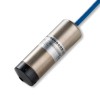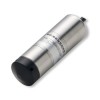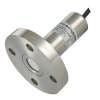Find industrial HART level transmitters offering superimposed digital communication on 4-20mA signals for remote access, troubleshooting & asset management.
HART liquid level transmitters utilize the widely adopted Highway Addressable Remote Transducer protocol, superimposing a digital communication signal onto the standard 4-20mA analog output loop. This capability allows process engineers and instrument technicians to remotely configure parameters, monitor advanced diagnostics, and retrieve device status information using a Distributed Control System (DCS) or a dedicated HART communicator, streamlining commissioning, maintenance, and integration into process control systems without requiring additional wiring infrastructure.
 LMK458 Marine Approved Hydrostatic Level Transmitter - Marine approved level transmitter with 4-20mA output for measuring level of contents inside ship ballast, fuel, liquid cargo or wastewater tanks
LMK458 Marine Approved Hydrostatic Level Transmitter - Marine approved level transmitter with 4-20mA output for measuring level of contents inside ship ballast, fuel, liquid cargo or wastewater tanks DPT200 Pressurised Tank Level Differential Pressure Transmitter - Pressurised tank liquid level differential pressure cell transmitter for process plant storage.
DPT200 Pressurised Tank Level Differential Pressure Transmitter - Pressurised tank liquid level differential pressure cell transmitter for process plant storage. LMK382 Low Range IP68 Waste Water Level Transmitter - Submersible Low Range waste water level transmitter with intrinsically safe option for monitoring the level of sewage and effluent in water treatment plants.
LMK382 Low Range IP68 Waste Water Level Transmitter - Submersible Low Range waste water level transmitter with intrinsically safe option for monitoring the level of sewage and effluent in water treatment plants. LMK457 Marine Approved Level Transmitter - Marine approved level transmitter with 4-20mA current loop output for shipbuilding with optional all CuNiFe construction for sea-water compatibility in ranges from 0.4 mH2O to 250mH2O gauge.
LMK457 Marine Approved Level Transmitter - Marine approved level transmitter with 4-20mA current loop output for shipbuilding with optional all CuNiFe construction for sea-water compatibility in ranges from 0.4 mH2O to 250mH2O gauge.
- Measuring fuel and water tank levels on ferries with a hydrostatic transmitter
- Hydrostatic level sensor for 7m high tanks with 4-20mA plus HART coms
Find out more about HART® Liquid Level Transmitters to determine which product options and capabilities will best meet your application requirements.
HART liquid level transmitters are specifically designed to integrate seamlessly into modern process control architectures using the Highway Addressable Remote Transducer (HART) communication protocol. This protocol is the prevailing standard for smart field devices, enabling bi-directional digital communication to occur simultaneously with the conventional 4-20mA analog level signal. The core advantage lies in transmitting digital data over the existing analog wiring infrastructure, eliminating the cost and complexity of installing separate communication cables.
A key operational benefit for process engineers and instrument technicians is the ability to perform remote configuration and parameter adjustments. Using a host system such as a Distributed Control System (DCS), an asset management system, or a handheld HART communicator, personnel can interrogate the level transmitter, set the measurement range (zero and span), define engineering units, and adjust damping settings without needing physical access to the device, which is particularly advantageous for transmitters installed in hazardous areas or difficult-to-reach locations like tall tanks or sumps.
The technology facilitates this dual signaling by employing Frequency Shift Keying (FSK). A low-level digital signal, typically encoding device parameters, diagnostic alerts, or additional process variables, is superimposed onto the primary 4-20mA analog current loop. This digital signal operates at specific frequencies (1200 Hz and 2200 Hz representing binary 1 and 0) that do not interfere with the integrity of the analog level measurement, ensuring both signals coexist reliably on the same pair of wires.
Beyond configuration, the HART protocol provides access to valuable diagnostic information directly from the liquid level transmitter. Technicians can remotely query the device’s status, identify potential faults (e.g., sensor malfunction, configuration errors), track operational hours, and receive alerts, significantly enhancing troubleshooting efficiency and enabling proactive maintenance strategies. This continuous health monitoring helps minimize process downtime and reduces the need for routine physical inspections.
In many industrial settings, such as chemical processing plants monitoring reactor vessels, water treatment facilities managing basin levels, or refineries gauging storage tanks, HART liquid level transmitters streamline operations. The ability to access enhanced diagnostics and perform remote configuration reduces field time for technicians and simplifies compliance checks and calibration verification processes, integrating smoothly with plant-wide control and asset management systems.
Product Help
Device information retrieval
What type of information can you retrieve from a liquid level transmitter using HART communications?
All types of HART enabled liquid level transmitters are required to include the following device information, which are retrieved using Universal Commands:
- Manufacturer name
- Product type
- Liquid level value and units (Primary Variable)
- Output signal and % of scale
- Message (32 characters)
- Liquid level range (Lower Range Value – LRV & Upper Range Value – URV)
- Liquid level range limits (Lower Sensor Limit LSL & Upper Sensor Limit USL)
- Liquid level unit
- Damping time constant
- Final assembly number
In addition to the above Universal Commands a manufacturer may also include further device information such as:
- Date
- Tag number
- Device ID
- Temperature value and units (Secondary variable)
- Software version number
User device configuration
What can you configure on a liquid level transmitter using the HART coms protocol?
There are some basic operations that are essential for a user to configure in the field such as the following which are usually available via most HART communication terminals:
- Re-range LRV & URV
- Change the damping time constant value
- Set Tag number
- Change liquid level units
Checklist for HART liquid level transmitter requirements
Define your HART liquid level transmitter requirements using this checklist:
- Liquid level range?
- Output signal? 4-20mA with HART coms
- Electrical connection?
- Process connection?
- Process media type?
- Hazardous area?
